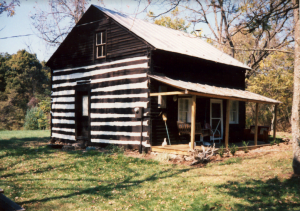
The first white man to claim Brocks Gap land was Benjamin Burden in 1734 when he surveyed 800 prime acres inside Brocks Gap, including Chimney Rock. Others soon moved here: in 1740, Thomas West near Bergton and Bernard McHenry near Clover Lick. Nicholas Cain moved to Brocks Gap in Winter 1740-41, along with Custers, Mauks, Trumbos, and Shoemakers. The Cains owned 100 acres across the North Fork from Riverside Church.
Historian Wayne R. Cain wrote, “For the next ten years[1741-1750s], life here in the valley settled down into one of common everyday work and growth. Nicholas [Cain] and his brother John made frequent hunting trips into the unsettled lands… The French and Indians of the northwest were, so far, at peace.”
However, in Summer 1755, while on its way to Fort Duquesne (Pittsburgh) to push the French out of the area, General Braddock’s British army was defeated by the French and their Indian allies. Braddock’s defeat left the western frontier like Brocks Gap vulnerable to attack. So many families fled that in September 1755, Governor Dinwiddie published a notice in the Virginia Gazette,saying that inhabitants had “most shamefully deserted their Plantations, for Fear of an Enemy” who could easily have been defeated by a few brave men. He added that it was safe to return to their farms, because he had sent Col. George Washington and five companies of Rangers and volunteers to defend them.
The Governor’s words did not satisfy Nicholas Cain. He bought land in Louisa County in 1756 and moved his family to safety in Spring 1757, a wise decision. The situation at Brocks Gap got worse. Court summonseswere delayed “by reason of the Indians” (June 1757), and “presence of the Indians” (November 1757). Some Brocks Gap families attended Linville Creek Baptist Church, whose minutes recorded in January 1757, “After this Time, the Spring coming on, the Indian Troubles continued, and all opportunities of Meetings were taken from us… the whole Neighborhood forced either to go into Forts or over the Mountains, to escape their Rage.”
Our Brocks Gap fort was at Third Hill, commanded by Captain Peter Hogg. It was built before July 1756 when a Council of War mentioned it. A native of Scotland, Hog had served with George Washington in 1754 on a fort-building expedition. A company of Rangers was stationed at Fort Hog, but they still could not prevent a “Dutch” person from being killed and 2 taken prisoner in November 1757. In January 1758, John States and Abraham Merchant were killed, and on March 19, 1758, William Clepole was killed.
In 1758, Capt. Hog sent about a third of his Rangers to aid Capt. James Dunlap at Fort Upper Tract (now Pendleton County). Dunlap, the Rangers and fort inhabitants were all killed by the Indians April 27, 1758. The next day the Indians captured Fort Seybert, killed residents, and took prisoners. Tradition says that when the fort was attacked,many Fort Seybert men were in Brocks Gap buying spring supplies.
After the two forts were destroyed, Capt. Hog wrote to the Virginia government that Gap inhabitants threatened to move off their farms if Hog’s Rangers were withdrawn. His second letter told of the two forts’ being destroyed by the enemy along with a third of his company (sent to aid Dunlap). The Council ordered Capt. Hog to “augment his Company to a Hundred Men, to be station’d at Brock’s Gap, Dry-River Gap, or such other places…”
Cain family tradition relates that Arnold Custer from Runions Creek and John Cain were killed in Spring 1759. Captain Hog was still in charge of the fort in 1759, but it is unclear when the fort was deactivated. Linville Creek church minutes told that the situation got better in the Summer of 1759, “our Armies victorious in the North Part of our Continent, which drew the Enemy from us…”
Fifty years later, the Fawley family bought Fort Hog’s site. Descendants remembered the two-story log kitchen building which had been part of the fort. It stood next to the existing (2021) log home. There were loopholes in all walls except the north wall which had a stone fireplacelarge enough for three kettles. The kitchen was demolished before 1930, but foundation stones were still visible in 1966. The existing log house was made from logs of the palisade, according to the late Merlin Turner. Astrong spring near the house and a well in the yardprobably provided water for the fort.
These days if I feel discouraged, I remember what terrors my Gap ancestors endured, and I thank God for present peace and safety.




























